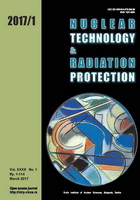
THE SENSITIVITY STUDIES OF A LANDMINE EXPLOSIVE DETECTION SYSTEM BASED ON NEUTRON BACKSCATTERING USING MONTE CARLO SIMULATION
Pages: 37-43
Authors: Hamda Khan, Zafar Ullah Koreshi, and Muhammad YaqubAbstract
This paper carries out a Monte Carlo simulation of a landmine detection system, using the MCNP5 code, for the detection of concealed explosives such as trinitrotoluene and cyclonite. In portable field detectors, the signal strength of backscattered neutrons and gamma rays from thermal neutron activation is sensitive to a number of parameters such as the mass of explosive, depth of concealment, neutron moderation, background soil composition, soil porosity, soil moisture, multiple scattering in the background material, and configuration of the detection system. In this work, a detection system, with BF3 detectors for neutrons and sodium iodide scintillator for γ-rays, is modeled to investigate the neutron signal-to-noise ratio and to obtain an empirical formula for the photon production rate Ri(n,y)= SfGfMf (d,m) from radiative capture reactions in constituent nuclides of trinitrotoluene. This formula can be used for the efficient landmine detection of explosives in quantities as small as ~200 g of trinitrotoluene concealed at depths down to about 15 cm. The empirical formula can be embedded in a field programmable gate array on a field-portable explosives' sensor for efficient online detection..
Key words: explosive, land mine detector, thermal activation, moderator, Monte Carlo
FULL PAPER IN PDF FORMAT (1.56 MB)
